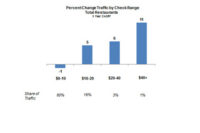Fast Food’s Popularity Among Lower- and Middle-income Families

"There is a correlation between obesity and lower income, but it cannot be solely attributed to restaurant choice," J. Paul Leigh, professor of public health sciences at UC Davis and senior author of the study said in a statement released by UC Davis Health System. "Fast-food dining is most popular among the middle class, who are less likely to be obese."
In conducting the study, Leigh and co-author DaeHwan Kim, specialists in health economics, used data from the “1994 to 1996 Continuing Survey of Food Intakes by Individuals” and the accompanying “Diet and Health Knowledge Survey.” The nationally representative sample of nearly 5,000 people in the U.S. included data about food consumption patterns, including restaurant visits, over two nonconsecutive days, which was compared with demographic variables such as household income, race, gender, age and education.
They found that eating at full-service restaurants, which involve a range of food choices and sit-down service, followed an expected pattern: as income rose, visits increased. In contrast, eating at fast-food restaurants, characterized by minimal table service and food preparation time, followed a different pattern. Fast-food restaurant visits rose along with annual household income up to $60,000. As income increased beyond that level, fast-food visits decreased.
Leigh noted that the fast-food industry attracts the middle class by locating restaurants right off freeways in middle-income areas and by offering products that appeal to a large proportion of Americans.
"Low prices, convenience and free toys target the middle class--especially budget-conscious, hurried parents--very well," said Leigh.
Additional correlations revealed in the study included:
* Men were more likely than women to go to both fast-food and full-service restaurants.
* People with more education were more likely to go to full-service restaurants.
* People who worked more hours were more likely to go to both fast-food and full-service restaurants.
* Smokers were more likely to go to fast-food rather than full-service restaurants.
The study was limited by the fact that the data came from the mid-1990s, the most recent information available on this subject. Although incomes have changed considerably since then, Leigh believes that the eating-out patterns found in this study would still hold if more up-to-date data were available.
"It has traditionally been difficult to define patterns of restaurant consumption for Americans according to their incomes," said Leigh. "By using a very large, nationally representative database that includes detailed information on income, we have solved that puzzle."
Kim and Leigh's study, "Are Meals at Full-Service and Fast-Food Restaurants 'Normal' or 'Inferior'?", is published online in Population Health Management and will be published in the December print issue of the journal. The research was funded in part by the National Institute of Occupational Safety and Health.
From the November 2, 2011, Prepared Foods' Daily News.
Looking for a reprint of this article?
From high-res PDFs to custom plaques, order your copy today!





